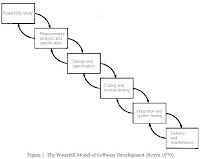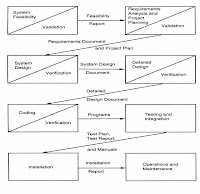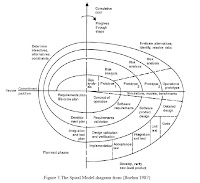Consider your school, how do you know that the life cycle was developed specifically for the university. How do we know it meets our needs?
Shown in the figure above is my own perspective of our university’s life cycle. One of the missions of the university is to produce world class graduates thus the university had formulated certain standards which are seen and reflected on the curriculum of each program. The starting point of the life cycle of our school is the formulation of a good curriculum. Formulation of a curriculum includes gathering of data and analysis of data. This phase produces a product which is called a curriculum. A curriculum is made to be a tool to achieve some of the Vision,
The next phase would probably the testing phase as I assume that all curriculum are tested to see if they really do meet standards. It would be a disgrace to implement a curriculum which is substandard. This is right as any product must undergo a testing first before releasing it to the public. As you can see on the figure above the testing phase is connected to two other phases which are the “Formulate Curriculum” phase and the “Implement Curriculum” phase. It illustrates that after formulating a possible good curriculum it would go undergo several in-depth testing. This is done to make sure that the curriculum is worthy enough to be implemented. Needless to say a bad curriculum is sent back to the initial phase as it again is analyzed and developed further.
The next phase is the implementation of the curriculum wherein students are enrolled in an academic program where the curriculum is used. Implementation of a certain curriculum takes a long time as an average curriculum lasts for four years. Implementation phase is where the data collected and analyzed during the formulation phase is used. If the implementation is successful therefore there is also a chance that world class graduates are also produced.
The next phase is the evaluation of the curriculum which I think is essential and important on the life cycle. This is the phase wherein a curriculum is evaluated and analyzed again to see if it still meets the need of the society and if it still in line with mission of the university. It is known that curriculum changes from time to time as the need of the society is changing. As technology advances there is a great need to reevaluate the curriculum to see if it still meets the standard. I personally believe that this phase is very crucial to the life cycle of this university because this is the phase wherein we realize the current curriculum is obsolete.
On the question, “How do you know that the life cycle was developed specifically for the university?” I think we could see it if it fits and relates to the Vision,
How do we know it meets our needs? In my own idea, I think the current life cycle is still meeting our needs as the university is still producing world class graduates as reflected on examination passers and achievements of individuals who graduated from our university. As discussed earlier there is a certain limit on how long could it meet our needs because technology is fast advancing and so must our curriculum. A good curriculum is not only measured by the graduates it produces but also the timeliness or the relevance of the curriculum on the society. For example, past curriculum for Education programs does not include computer subjects but as technology advances the curriculum adapted to the society and was revised to include computer subjects in the curriculum.
USEP’s Roots
The University of Southeastern Philippines (USEP) is a regional state university created in 1978 through Batas Pambansa Bilang 12. The university is an integration of four state institutions, particularly, the Mindanao State University-Davao, the University of the Philippines-Master of Management Program in
The university has four campuses, namely, Obrero (main) and Mintal Campuses in
The USEP offers graduate and undergraduate academic programs in the fields of engineering, education, arts and sciences, economics, business, computing, governance, development, resource management, technology, agriculture and forestry.
The
To provide programs of instruction and professional training primarily in the fields of science and technology, especially medicine, fisheries, engineering and industrial fields.
To promote advanced studies, research and extension services and progressive leadership in science, agriculture, forestry, fisheries, engineering and industrial fields and other courses needed in the socio-economic development of Mindanao.
To develop courses at the graduate level along the fields of specialization and to respond to the needs of development workers in the academic community.
To provide non-formal education and undertake vigorous extension and research programs in food production, nutrition, health and sports development.
To offer scholarship and/or part-time job opportunities to deserving students from low-income families.
USEP shall produce world-class graduates
and relevant research and extension
through quality education and sustainable resource management.
Particularly, USEP is committed to:
Provide quality education for students to grow in knowledge, promote their well-rounded development, and make them globally competitive in the world of work;
Engage in high impact research, not only for knowledge’s sake, but also for its practical benefits to society; and,
Promote entrepreneurship and industry collaboration.
Vision
A PREMIER UNIVERSITY IN THE ASEAN REGION
By becoming a premier university in the ASEAN Region, the USEP shall be a center of excellence and development, responsive and adaptive to fast-changing environments. USEP shall also be known as the leading university in the country that fosters innovation and applies knowledge to create value towards social, economic, and technological developments.
Goals
Aligned with the university 's vision and mission are specific goals for Key Result Areas (KRA) on Instruction; Research, Development, and Extension; and Resource Management:
KRA 1. Instruction
Produce globally competitive and morally upright graduates
KRA 2. Research, Development, and Extension (RDE)
Develop a strong R,D,&E culture with competent human resource and responsive and relevant researches that are adopted and utilized for development
KRA 3. Resource Management
Resources:
usep.edu.ph

















